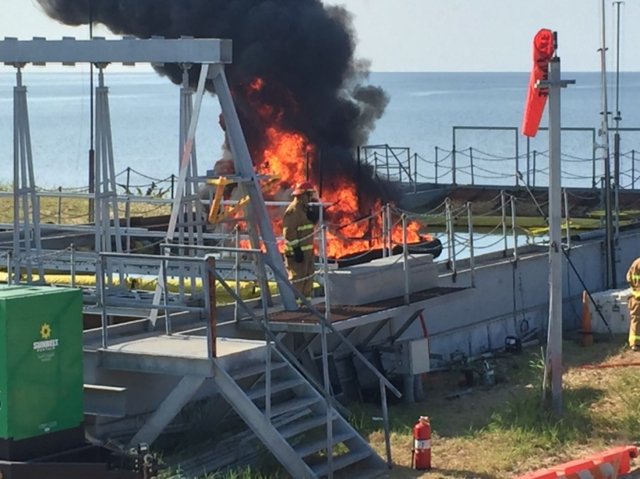EPA Researchers Partner with Canadian Researchers to Ensure Effective Responses to Oil Spills

Published August 29, 2022
The U.S.-Canada border is the world’s longest shared border and includes four of the five Great Lakes, many rivers, additional lakes, major airsheds and migratory routes for wildlife species. In addition, there are many Native American Tribes and First Nations residents whose culture extends across the border.
This expansive, shared boundary brings shared natural resources and interests. Close cooperation among many U.S. states, Canadian provinces, Tribes, First Nations, and federal and local governments is needed to protect human health and the environment. One critically important goal of this partnership is protecting the fisheries, their surrounding coastal communities and shorelines, aquatic and deep ocean communities, wildlife, and people from the risk of oil spills and other accidents. Large scale oil spill events like the Exxon Valdez and Deepwater Horizon oil spills endanger public health, contaminate drinking water, devastate natural resources, and disrupt the economy.
Once spilled, oil immediately begins to move and weather, breaking down and changing its physical and chemical properties. As these processes occur, the oil threatens surface resources and a wide range of subsurface aquatic organisms linked in a complex food chain. Many different aquatic habitats exist, with varied sensitivities to the harmful effects of oil contamination, along with different abilities to recuperate from oil spills. In some areas, habitats and populations can recover quickly. In other environments, however, recovery from persistent or stranded oil may take years.
The persistence of oil in seawater after a spill, and the transformation it undergoes, has prompted intensive study of the long-term fate of oil and the manners in which it degrades. The ultimate fate of oil and oil products in the environment depends on their composition, source, and persistence. Most research has focused on the fate of petroleum products depending on whether chemical dispersants were used to clean them up. However, dispersants may be less frequently used during a spill compared to surface washing agents. These include formulated cleaners, similar to dishwashing soaps, that are designed to dissolve or lift the oil without spreading. Additionally, the development of new herding agent formulations that push thin slicks together has drawn attention to these products as a possible response option to be used in concert with controlled burns for more effective oil burning. This research helps responders decide what the best option for clean up is based on the situation.
The United States and Canada have one of the world's oldest and most effective environmental partnerships. A new element of this partnership was initiated in 2019 when EPA entered into a multi-year Cooperative Research and Development Agreement (CRADA) with the Department of Fisheries and Oceans Canada (DFO). Under this agreement, EPA Research Ecologist and Oil Spill Response Research Area Lead, Dr. Robyn Conmy, along with a team of EPA scientists, conducted toxicity, biodegradation, and chemical characterization experiments related to oil spill cleanup. Toxicity testing was conducted off site with partner laboratories in Florida and California. The remaining work was conducted at EPA’s research facility in Cincinnati, OH. Partners used the results to assess oil spill alternative response measures, focusing on marine environments.
Conmy and the team assessed the toxicity of controlled burning residues on aquatic species such as algae, crustaceans, fish, urchins, and insects for surface washing agents and chemical herders. In addition, biodegradation of oil was determined using high-latitude oil-degrading microbial cultures. Sensitivity of test species to oil and treating agents was determined using three surface washing agents and two chemical herders listed on the National Oil and Hazardous Substances Pollution Contingency Plan Product Schedule (NCPPS).
EPA has the regulatory responsibility to maintain the NCPPS, which lists commercially available treating agents for oil spill response operations. EPA researchers develop the effectiveness and toxicity protocols for the NCPPS to enhance preparedness efforts by EPA regions and on-scene coordinators, along with other first responders, to protect impacted communities from exposures to oil and fuel releases.
Potential findings from the team’s research will expand the knowledgebase of using chemical treating agents on petroleum oils, both weathered and fresh, by (1) determining if cold-water species are sensitive to oils treated with agents, (2) assessing the toxicity of in situ burn (ISB) residues, (3) assessing the ecological relevance of laboratory toxicity tests, and (4) characterizing biodegradation of oil exposed to treating agents by high-latitude microbial cultures. This work is critical given that these agents are more frequently used as oil spill response options. This research effort is estimated to conclude this year.
“As a result of the CRADA with the Canadian Government through the Multi-Partner Research Initiative, EPA’s research is addressing knowledge gaps and providing support to the United States and international on-scene coordinators and responders to advance science-based decision-making during an oil spill event,” said Conmy. “As part of the CRADA, we have developed multiple international collaborations with university, National Laboratory, and other Agency partners,” Conmy continued.
As a result of this research, EPA’s research team has published numerous scientific articles and reports, as well as communicated EPA science at international science conferences.
Learn more:
- Toxicity of oil spill response agents and crude oils to five aquatic test species.
- Toxicity of sediment oiled with diluted bitumens to freshwater and estuarine amphipods.
- Comparative toxicity of oil spill herding agents to seven aquatic species.
- What is an Airshed
- EPA Oil Spill Research
- Multi-Partner Research Initiative
